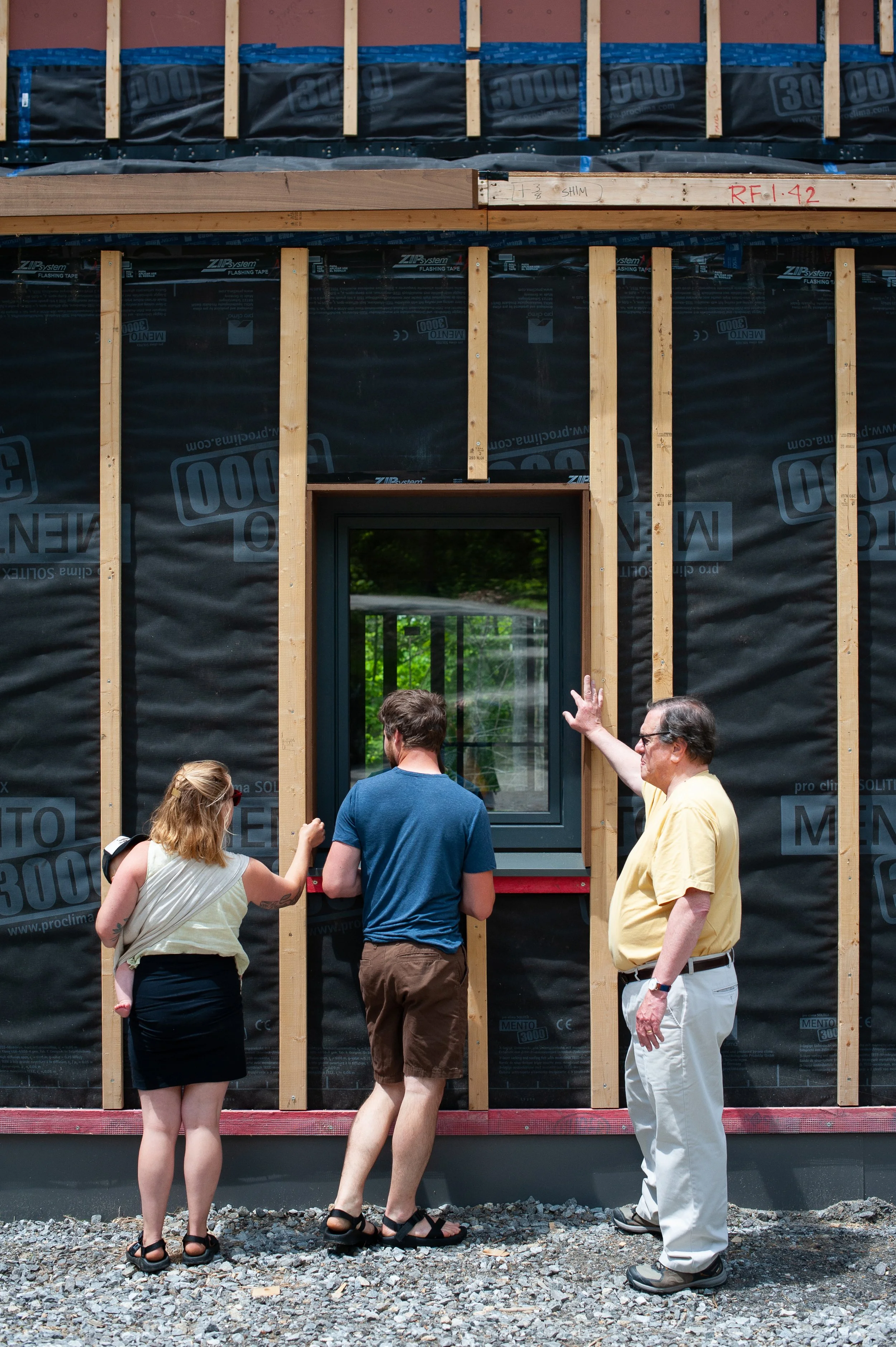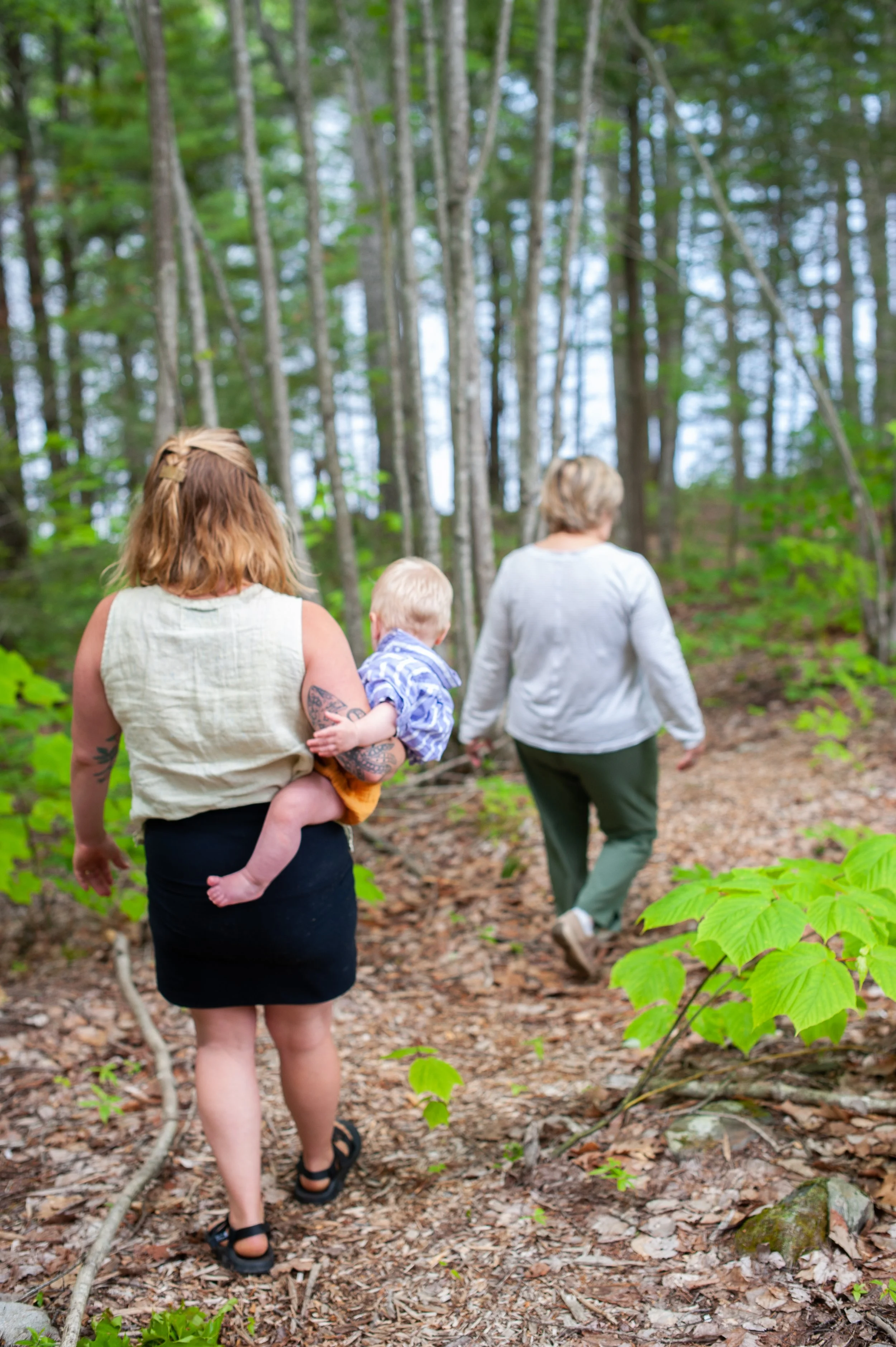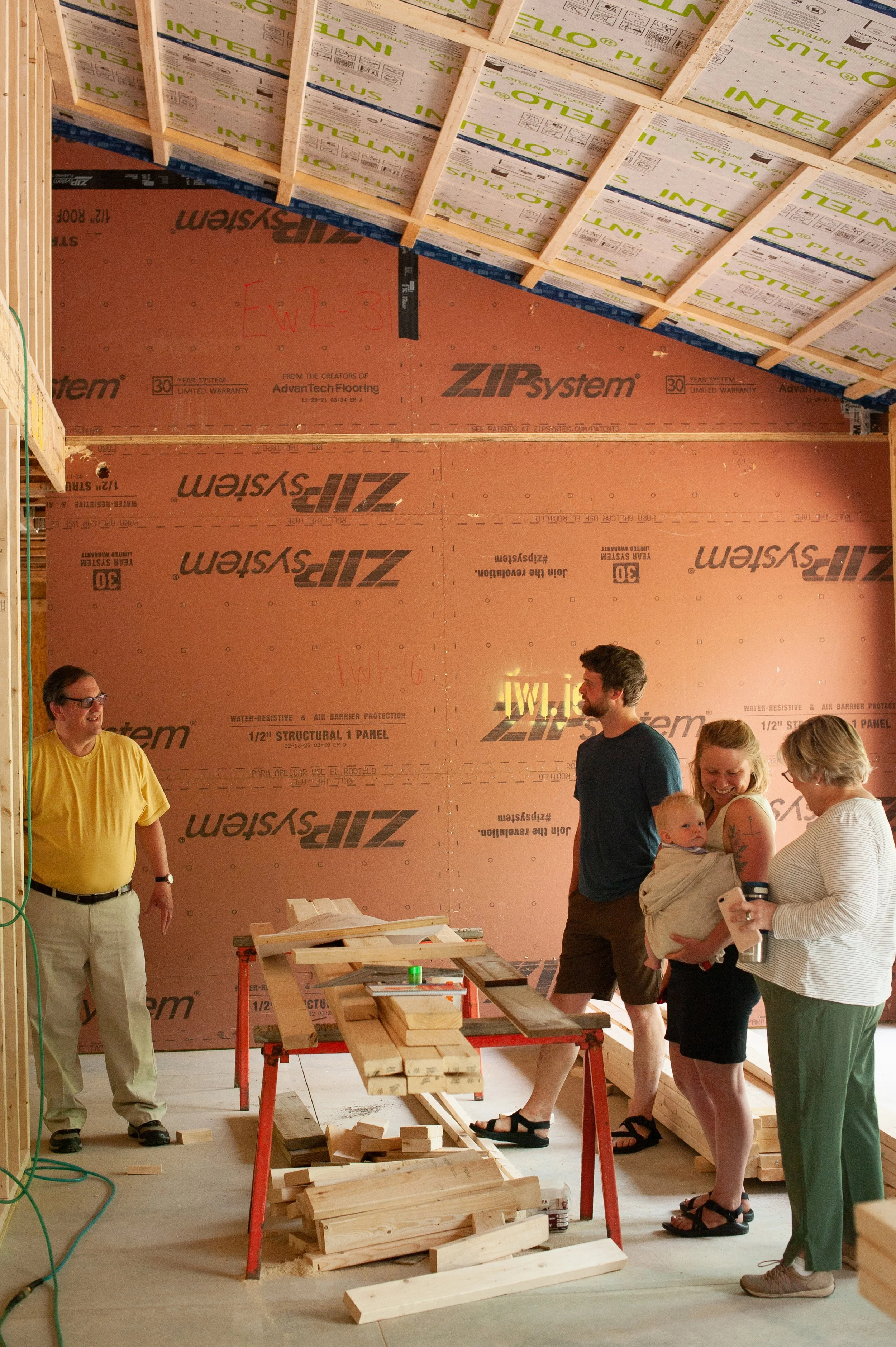1700 Interview
Photo by Lily Piel for GO Logic
With zero chance of missing out on a relationship with their new grandbaby, Don and Kitty ‘walk the walk’ in a new panelized, passive house, GO Home.
A few weeks after the set crew put their house together in just five days, Don and Kitty sat down with GO Logic to tell the story about how they came to commission a 1700 sf GO Home on a freshwater site in Midcoast Maine.
AT: Tell me about the journey that led you to want to move to Maine and build a GO Home.
Kitty: Our daughter was finally settled and we really wanted to be able to spend time with her. Because our daughter and her husband weren’t going to be able to spend time in Rhode Island, it became clear that we were going to need to find a house up there.
Don: We looked at a ton of houses, but none of them fit the bill.
Kitty: Years before, our daughter and a boyfriend had fallen in love with a piece of land on Webber/Muscongus Pond in Bremen, and we looked at it, and it seemed like there were going to be a lot of roadblocks to developing it. When none of the houses we looked at seemed to work for us, we were looking at a house across the street from Webber, and we looked at the map and saw that there was a pond on the other side of the street. We were looking at a house on saltwater, but I always preferred to be on fresh water. I grew up in summers on a lake in Maryland, so fresh water was always special for me. So, we asked the realtor to explore if the owners would be interested in selling it, and she did and they were.
Don: We were looking at houses until we saw a perfect building site on raw land. It was so close to our daughter and son in law, and to the ocean, but with fresh water.
We had built the house we lived in in Rhode Island, and we really liked our experience working with architects and designers to build a creative space, so this land made a ton of sense.
AT: Two questions: I heard you say a big motivation was to spend time with your daughter and her family, I’m wondering if there’s more to it than just that. Second, what about the other houses that weren't fitting the bill?
Kitty: Because she’s an only child, we do have a closer connection. Even though as a teenager she was a bit rebellious, when she got into college with other kids her age with other backgrounds, I think she realized that what she had with us was pretty sweet and it became really clear that we just enjoyed spending time with each other. Then when she got pregnant, we wanted to be involved in our grandchildren’s lives.
Her grandparents, one set lived in D.C., the other in Chicago and then Florida.She got to see them sometimes, but not often, and it was a shame that she didn’t get to know them better.
Photo by Lily Piel for GO Logic
Don: I think you’d want to know how Kitty came to find GO Logic.
Kitty: When our daughter and her husband were looking at a place to buy, they started looking at land. They were thinking of putting up a prefab. So I was looking online for prefabs in Maine. And obviously GO Logic’s GO Home models were one of the first ones to come up. The designs immediately appealed to me. In the end, they bought a 1790’s farmhouse, which is very different from what we were looking at, but it's a lovely house. But then when we started looking for land I thought, ‘Let’s go look at what might fit our needs.’
Don: So by the time we met with GO Logic owner, Alan Gibson, Kitty was pretty determined to have a GO Logic house. There weren't any other options to consider, she had just fallen in love with the designs and the customizability.
Kitty: The architect that designed our old house in RI, we’ve admired his work a lot, but he’s gotten very hot down here. Whereas, we probably would have gone for a house designed by him, the wait list would have been 3yrs, so we decided no, let’s not. It was an easy choice to go with GO Logic.
Don: And it is always easier to build with a local designer than with someone from away. And we recognized our own limitations in terms of house maintenance, we are not that great at it. So, we really wanted an exterior surface that did not require maintenance. Kitty had seen this thermally modified poplar siding Cambia, when it became clear that this was a good maintenance free alternative and was a fantastic choice for us.
AT: What about the 1700 design spoke to you?
Kitty: It was one floor. Being able to live there (hopefully to the end) would have to be one floor.
Don: We weren't trying to go crazy with the design. One thing that we learned through COVID is that we can’t work in the same space. One of us is messy and one of us is neat. And Kitty really wanted a laundry room also, and being able to do that with no problem we really appreciated.
In our old house we had radiant heat. Loved it. At one point we talked to Alan about radiant, and he said it's really overkill for a passive house. And Kitty said, won't the floors be cold? He said, like a good Mainer, “wear slippers.”
AT: Is the fact that we only build passive house standard homes one of the drivers for choosing to work with GO Logic?
Kitty: We’ve been trying to live a sustainable lifestyle for 14yrs.
Don: We bought Prius’ when they first came out and then when Teslas first came out we bought ours before they’d hit 5000 on the assembly line. And not long after, we put solar on our house to disengage ourselves from the cost of electricity.
Photo by Lily Piel for GO Logic
AT: Where does your environmental motivation come from?
Don: For me, being interested in addressing climate change means you have to walk the walk and it has to start with whatever you can do. One person may not make the difference, but a million people make a big difference. Replacing a million gas cars with Teslas makes a big difference. Taking a million homes off fossil fuels makes a difference. Even though it only feels like it's you when you're doing it, we wanted to try to be leaders in trying to save the planet.
We lived on the water in Rhode Island in the best part of Narragansett Bay, within the first ten years of being there we went from being able to pick a lunch worth of mussels off of the beach in five minutes, to the mussels being unable to grow past the larval stage, even as the water got clearer and we were in one of the cleanest part of the Bay. The mussels were disappearing because the sea temperatures were rising. It was too warm. The local lobster industry was dying. We could see all of these changes right in front of us. It became imperative to try and stop the adverse change.
Kitty: In order to reach that house, you had to cross a causeway, and when we first built the house we had trouble during storms reaching the house maybe once or twice, but ten years down the road - the number of times that storms washed the road out were 5 times a year, then 8 times a year, and now if a storm hits during a king tide the road washes out. So, the effects of sea level rise were more obvious. Many others weren’t seeing it, but we were living it.
Don: Regarding the passive house standard of the house, when we put in a solar array at our RI house, we put in a 15kw system to offset the cars and house together, and we had an oil system for heat. Our new passive house allows us to go with a much smaller solar system and zero fossil fuels, for the same net-zero effect, which is a function of how efficient the house is.
Photo by Lily Piel for GO Logic
AT: What is the vision of your lives when you’re in the house? How do you picture your life when you’re up here?
Kitty: I think I will be spending quite a bit of time in Maine, probably three weeks a month. In the winter, I love snow, so that won’t keep me in RI because I'’d rather be in Maine with snow. In the summer, kayaking and swimming and spending time with family up there -– those are the things that appeal to me. Enjoying the woods, which is something we didn'’t have in Rhode Island, which brings me back to my childhood -– being in the woods.
We’ve got lots of friends in Rhode Island and we don't want to leave that behind, but the pull of family is strong. Based on how our lives unfolded with our parents as they aged, I know that our daughter will be the one to look after us, and we will need to be much closer to her. I’m guessing that the older we get, the more time we’ll be spending in Maine.
Don: For me, I felt this way in our old house and I think I'm going to feel this way about this new house:
It's like living in a piece of art that you love.
When your house is beautiful you never get tired of it. You never get tired of a gorgeous view. You never get tired of a sunset. You walk around and say I am so lucky to live here. It never gets old and every day is different.
Kitty: We’re very lucky that we can afford to live in such homes. And realize that there are lots of people who have no choice.
There was something else that I learned from our project manager, Megan. She mentioned that GO Logic looks into every piece of the building to make sure it's the most sustainable. And that's something that we hadn't been aware of. That actually, things like the plumbing fixtures, the standard options are the ones that they have researched and identified as the best choice. And we hadn't been aware of that, which is another reason that it's important to go with a GO Home.
Don: I’ll share one story to circle back on quality. I was talking to Justin, the shop manager, after the house was set and I asked him how he was feeling about everything and he shook his head and was like “we spend so much of our time building everything to millimeter standards, and the trusses are built to like ¾” tolerances and many were not exactly the same length. The truss manufacturer tells us not to modify them, and it's incredibly frustrating to spend another day on site to have the structural engineer come out to approve the modification of the trusses so that they are more exact.” He was like: “we are so attentive to every millimeter, and other people aren’t.” To me, that said a lot about who you guys are.
Photo by Lily Piel for GO Logic





